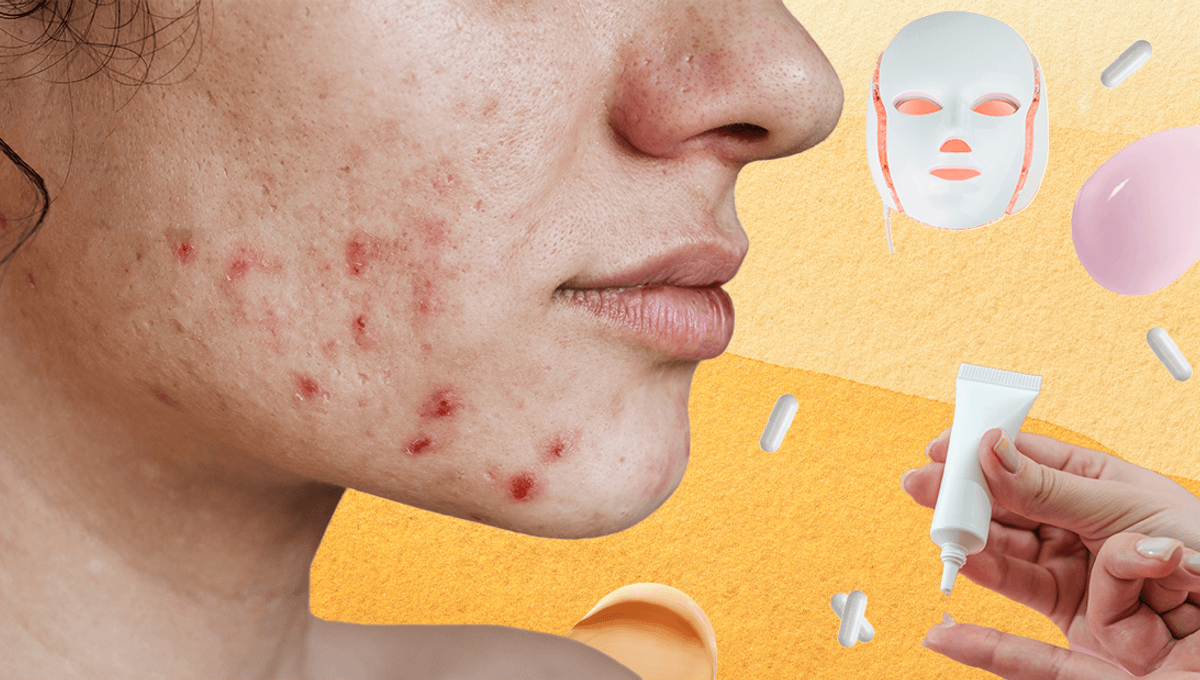
Acne affects many of us at one point or another, and most will be begrudgingly familiar with all of the cleansers, creams, and pills that aim to clear it up – but is there anything new on the horizon?
What is acne?
ADVERTISEMENT
Acne is a condition in which the pores in the skin become clogged up. When they’re blocked by a mixture of the oil produced in the skin, known as sebum, and dead skin cells, this can lead to blemishes known as whiteheads and blackheads. However, bacteria can also get trapped, which can cause inflammation, swelling, and redness, leading to pimples (which might be filled with pus) and cysts.
It can be triggered or worsened by certain factors, like medications – namely steroids – or hormonal changes. Some people who have periods, for example, can experience an acne flare-up just before their period starts.
Existing treatment methods for acne range from simple self-care, such as washing your face daily and making sure to remove makeup, to over-the-counter creams or gels containing compounds like benzoyl peroxide or salicylic acid, which aim to kill bacteria and unclog pores. If neither of these approaches work, someone with acne might be prescribed medications like antibiotics, higher-strength creams or gel, or in severe cases, isotretinoin (commonly known as Accutane).
Recent developments in acne treatment
While there are many treatments for acne already out there, that doesn’t stop researchers from looking for new ones that have the potential to be even more effective, and hopefully, with fewer side effects.
Old dogs, new tricks
Still, inspiration can often come from what we already have. That’s the case for one of the most recent FDA-approved treatments for acne – IDP-126, or Cabtreo™. This topical gel is a combination of the antibiotic clindamycin, benzoyl peroxide, and adapalene, a type of retinoid; all three have been approved to treat acne before, but together, they’re the first fixed-dose, triple-combo topical treatment to have been approved in the US.
Gaining FDA approval means successfully demonstrating a new medication is effective, and according to a 2024 review, IDP-126 appears to have achieved that. While it still has side effects, and there are limitations to be found in the individual studies investigating the gel, the review authors found that it significantly reduced both inflammatory and non-inflammatory acne, as well as improved patients’ quality of life.
ADVERTISEMENT
However, one area that still needs more attention is IDP-126’s efficacy compared to other acne treatments. In other words, it might work, but does it work any better than what’s already out there? Scientists will need to do more research to find out.
Probiotics
Since bacteria can contribute to the development of acne, antibiotics might seem like a good way of treating the problem. They can indeed be effective, but given that antibiotic resistance is a serious issue, researchers are looking for other ways we can tackle acne via targeting bacteria.
That could include probiotics, both topical and oral. Two recent reviews of studies investigating this possibility suggest that they could hold promise, finding that probiotics might be able to reduce acne lesions, inflammation, and redness, and positively alter the skin microbiome.
This isn’t to say everyone with acne should start necking a bunch of probiotic yogurt (or smothering it on their face); there are still enough limitations that probiotics can’t quite move from “promising” to actual treatment.
ADVERTISEMENT
For example, the studies had relatively small sample sizes, used a number of different strains of bacteria, and trialed the probiotic treatment for different periods of time – all of which makes it difficult to generalize their findings. It’s also worth noting that most of the studies investigated effects on mild to moderate acne, meaning the results can’t be reliably applied to people with more severe acne either.
Though still a worthwhile avenue to investigate, there’s still a lot more research to be done before a doctor might prescribe someone probiotics for their acne.
Visible light-based therapies
Medication isn’t for everyone, and light-based therapies are being touted as a possible alternative.
Some of those mildly terrifying red light therapy masks, for example, have recently been FDA-cleared for marketing for inflammatory acne. However, the jury is still very much out on the efficacy of this kind of visible light treatment for acne.
ADVERTISEMENT
A 2024 review found that while visible light therapy may be a safe and effective treatment for acne, current research has a whole host of limitations, ranging from small sample sizes and a lack of comparison with other acne treatments through to no consistent method of evaluating the severity of acne and even missing important data. Unsurprisingly, the authors of the review concluded that more research is needed to figure out if visible light therapy is an effective treatment for acne in the long term – both at the dermatologist’s office and at home.
All “explainer” articles are confirmed by fact checkers to be correct at time of publishing. Text, images, and links may be edited, removed, or added to at a later date to keep information current.
The content of this article is not intended to be a substitute for professional medical advice, diagnosis, or treatment. Always seek the advice of qualified health providers with questions you may have regarding medical conditions.
Source Link: Retinoids, Probiotics, And Visible Light Therapy: What's The Latest In Treating Acne?